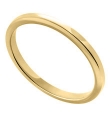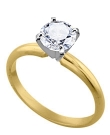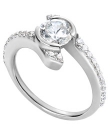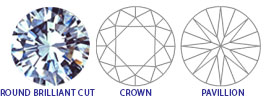14K Yellow Gold 2 mm Flat Edge Wedding Band




I ABSOLUTELY LOVE MY RING! I WAS SO NERVOUS OPENING THE BOX. I KEPT THINKING, I HOPE THAT I AT LEAST "LIKE IT"....I DON'T HAVE TO LOVE IT, BUT I HOPE I LIKE. I WAS WONDERFULLY PLEASED SEEING MY NEW RING AND I LOVE IT. I CAN'T KEEP THE SMILE OFF OF MY FACE. I THANK YOU SO MUCH FOR PUTTING YOURSELF IN MY SHOES AND SEEING TO IT THAT I GOT A RING THAT I WILL TRULY WEAR FOREVER! THANK YOU.
Judy

Round Brilliant Cut
Brilliant cut diamonds are scientifically found to reflect the most light and are considered to have the greatest brilliance of all cutting styles. Brilliant cuts can be any shape from square to oval. However, the round brilliant shape has set the standard for all other diamond shapes and accounts for more than 75% of diamonds sold today. Its 58-facet cut, divided among its crown (top), girdle (width part) and pavilion (base), is calibrated through a precise formula to achieve the maximum in fire and brilliance. It's divided into 7 parts. On the crown, there is a large octagonal table surrounded by 8 triangular star facets; 8 kite bezel facets and 16 triangular upper girdle facets, arranged in pairs that circle the crown's perimeter. A culet on the pavilion connects eight elongated, kit shaped pavilion mains to the girdles' edge. Separating the pavilion mains are 16 elongated, triangular lower girdle facets arranged in pairs. Personal trait of person favoring this shape: Family-centered, dependable and unaggressive.
 The Ideal Brilliant Cut
The Ideal Brilliant Cut
A diamond's brilliance depends on two key characteristics of its cut: symmetry and polish. Symmetry refers to the angles at which the "facets" (the stone's smooth, angled surfaces) align. Proper symmetry reflects light from one surface to another repeatedly throughout the diamond, allowing as little as possible to escape. The precision of the cutting dramatically affects the beauty and value of any diamond. This is why great emphasis is placed on "ideal cuts", to help consumers better understand the effects of precision cutting and to create guidelines in selecting a diamond that exhibits brilliance and fire.
Diamond cutting is an art form that is still evolving as new diamond cuts continue to be introduced. Today there are several differing formulas for cutting an ideal cut diamond. There is no consensus as to which is best, however, each method results in producing an exceptionally beautiful diamond.
Generally speaking, diamonds that are cut with smaller tables exhibit more fire, those with larger tables show more brilliance. Larger tables are more popular today because they give the illusion of a bigger diamond. Unfortunately, both fire and brilliance can't excel in the diamond. A larger table can create greater brilliance but may cause some reduction in fire; and visa-versa. No one has come to agreement on what the percentages should be. This is why there are several different types of proportioning found in diamonds and "best" is a matter of preference.
In 1919, Marcel Tolkowsky developed what he thought would be the best combination of angles to allow light to enter the diamond and be reflected back to create the best combination of brilliance and fire. His formula has provided the basis for today's "ideal cut diamonds". These ideal cuts often create perfectly aligned arrows and heart patterns that can be seen under magnification. Whatever ideal you choose will result in a very beautiful diamond.
